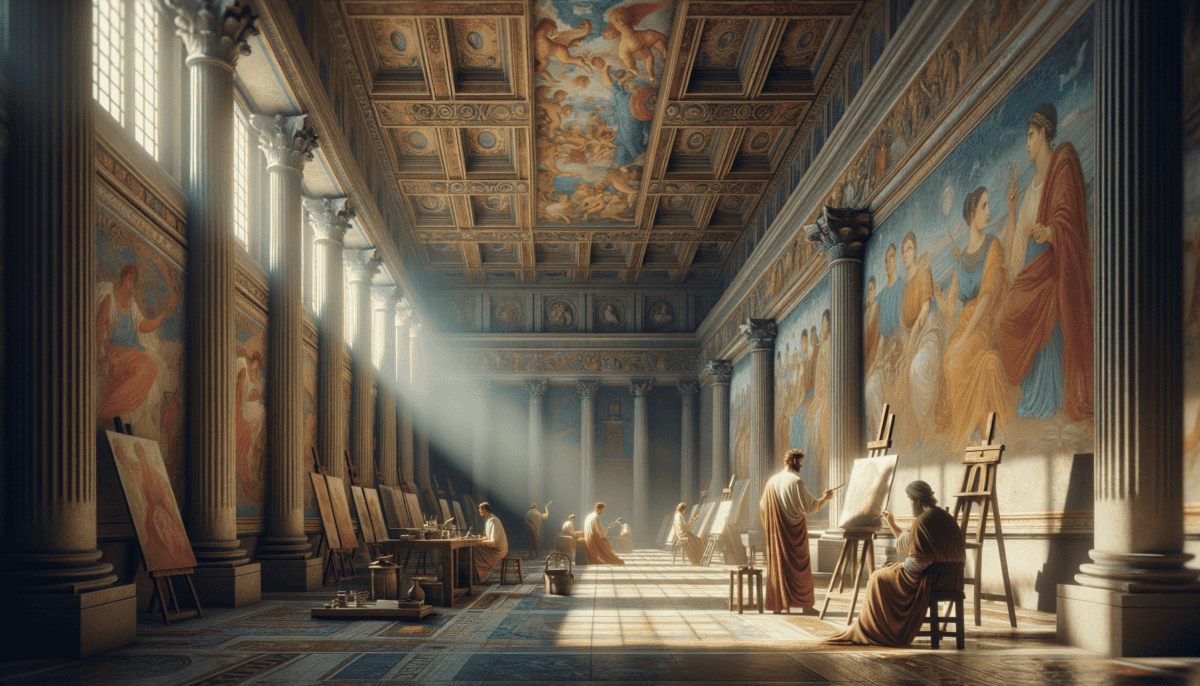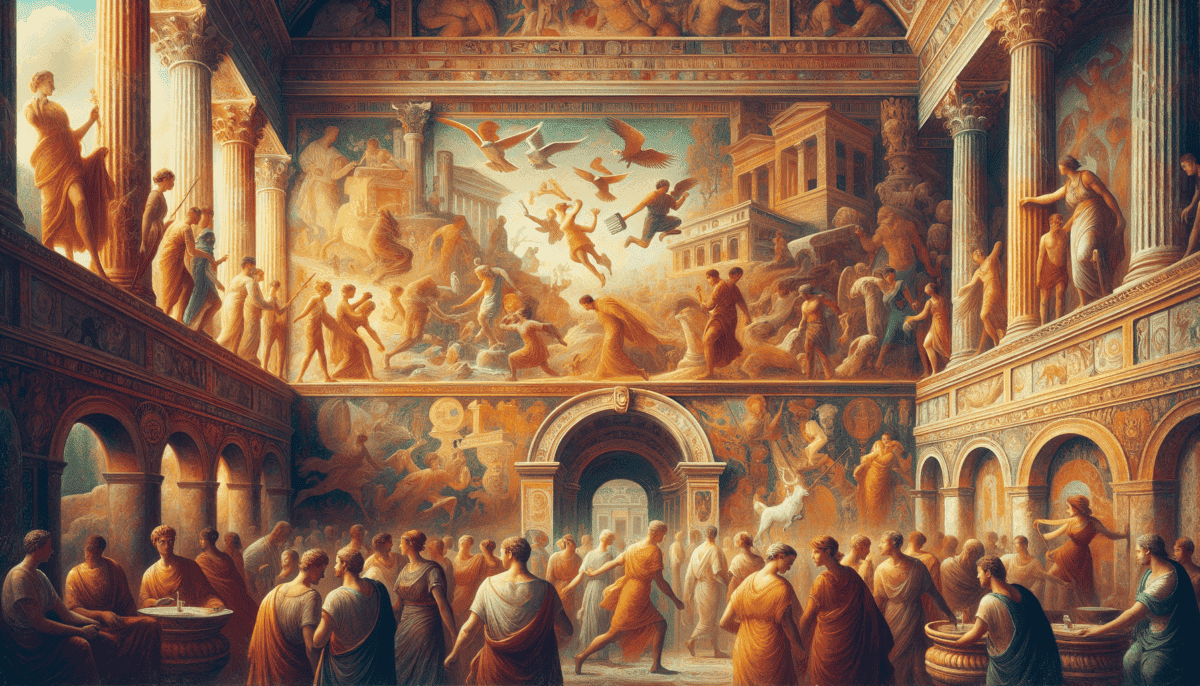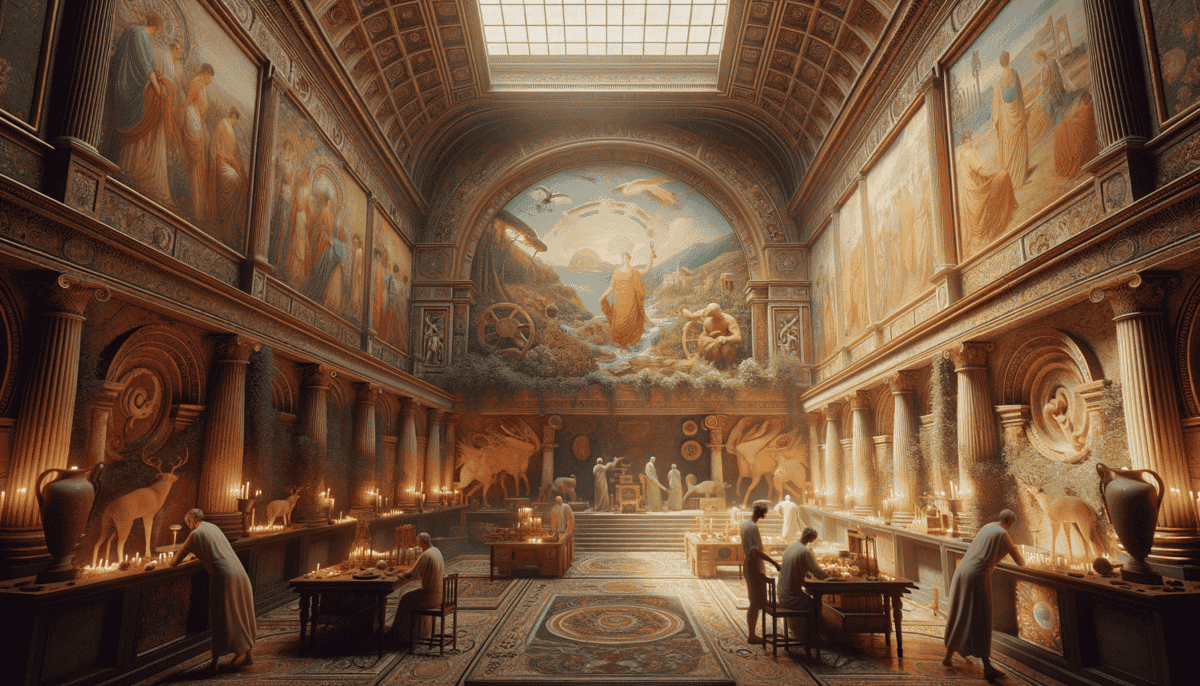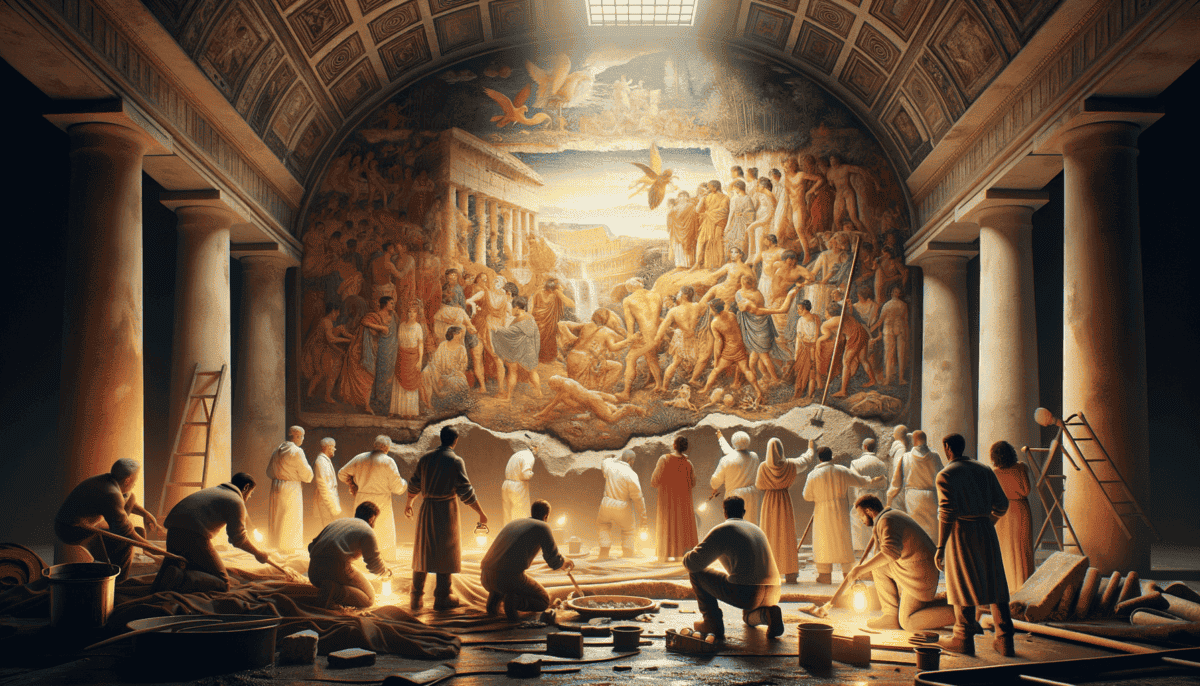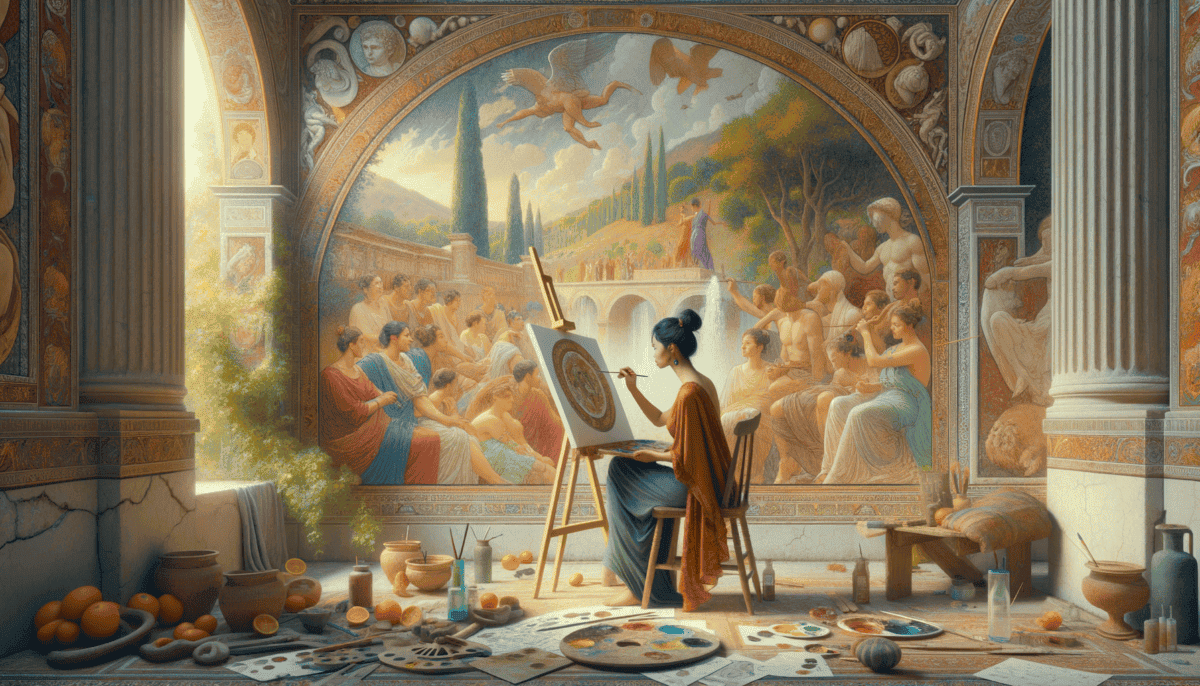The Buried City
Marcus wiped sweat from his brow as he painted the final touches on a beautiful garden scene. The warm Italian sun streamed through the villa's window. It was just another summer day in Pompeii – or so everyone thought.
"Papa, come quick!" Marcus's daughter Julia tugged at his toga. "The mountain is acting strange!"
Marcus looked up from his work. Through the window, he saw Mount Vesuvius belching dark clouds into the blue sky. The ground began to rumble beneath their feet.
"We must leave now!" Marcus grabbed Julia's hand. All around them, people were running through the streets. The sky grew darker and darker, like nighttime in the middle of the day. Hot ash began to fall like grey snow.
But not everyone made it out. The volcano covered the whole city in hot ash and rock. Pompeii was buried deep underground, along with all its beautiful wall paintings.
A City Frozen in Time
Many, many years later, some workers were digging a well. Their shovels hit something hard. It wasn't just rocks – it was an ancient wall!
"Look at these colors!" one worker gasped. Under all that dirt were paintings that looked as bright as the day Marcus painted them. There were pictures of gardens, animals, and people going about their daily lives.
Dr. Rosa Martinez carefully brushed dust from a wall painting. She was an archaeologist – someone who studies old things to learn about the past.
"These walls tell us so many stories," she said to her team. "Look at this one – it shows a family having dinner. And here's one of children playing games!"
The Mystery Begins
Each painting was like a window into the past. They showed what people wore, what they ate, and what they did for fun. But there were still so many questions:
• How did the Romans make such beautiful paintings?
• What do all the pictures mean?
• What other secrets are still buried under the ground?
The paint was still bright red, yellow, and blue after being buried for so long. How did they make colors that could last thousands of years?
Little Julia's voice seemed to echo through time: "Papa, tell me a story about the paintings!"
Marcus would never finish his last painting. But thanks to Vesuvius, his other works of art were preserved forever, waiting to tell their stories to people like Dr. Martinez.
As the sun set over the excavation site, Dr. Martinez carefully covered the newly discovered wall painting. Tomorrow would bring more discoveries, more colors, and more stories from the buried city of Pompeii.
The dig site grew quiet as night fell. But somewhere beneath the earth, countless more paintings waited to be found, each holding secrets about life in ancient Rome.
Colors of the Empire
Dr. Martinez stood in her lab, holding a tiny piece of bright red paint that was thousands of years old. “How did they make such beautiful colors?” she wondered.
“Look what I found in my research!” her assistant Tom exclaimed, rushing in with an old book. “The Romans were amazing artists who knew special secrets about making paint.”
The Paint-Makers’ Magic
In ancient Rome, making paint was like cooking a special recipe. Artists would:
• Mix them with water and lime
• Add special ingredients to make the colors stick to walls
• Paint quickly before the wall dried
“They used things from nature to make their colors,” Dr. Martinez explained to a group of visiting students. “Red came from special rocks. Blue came from crushed gems. Yellow came from clay found in the earth.”
Painting Like a Roman
Little Maria, one of the students, raised her hand. “But how did they put the paint on the walls?”
Dr. Martinez smiled. “They had a very clever way! First, they covered the wall with wet plaster – like cake frosting. Then they had to paint really fast before it dried. This way, the paint became part of the wall!”
Tom brought out some examples of Roman wall paintings. The children gasped at the beautiful pictures. There were:
️ Fancy houses with columns
Gardens full of flowers
Wild animals from far away lands
People having parties and celebrations
A Rainbow of Meanings
“In Rome, the colors you used in your house told people how rich you were,” Dr. Martinez explained. “Purple was super special – only very wealthy people could afford it!”
Maria’s eyes grew wide. “Like having the newest phone today?”
“Exactly!” Dr. Martinez laughed. “The fancier your wall paintings, the more important people thought you were.”
The Artists’ Secret Code
Roman artists followed special rules for their paintings. They had four main styles:
Style 1: Made walls look like they were made of fancy marble
Style 2: Made fake windows with pretty views
Style 3: Told stories from history and myths
Style 4: Mixed all the styles together in new ways
“It’s like they were the first interior decorators!” Tom joked, making the students giggle.
As the day ended, Dr. Martinez carefully put away her samples. “Tomorrow we’ll look at some of the stories these paintings tell,” she promised the excited students.
That night, she dreamed of Roman artists mixing their magical colors, telling stories that would last for thousands of years. The walls of Pompeii still had many colorful secrets to share.
Tales from Ancient Walls
The morning sun streamed through the museum windows as Dr. Martinez gathered her students around a newly discovered wall painting. The colors were still bright after 2,000 years!
Hidden Stories
“Look at this painting!” Maria pointed excitedly. “Is that a superhero?”
Dr. Martinez smiled. “Close! That’s Hercules, one of the most popular heroes in Roman stories. The Romans loved painting their favorite tales on their walls.”
• Brave heroes and monsters
• Gods and goddesses
• Happy parties and festivals
• Daily life at home
• Beautiful gardens
A Day in Roman Life
“The Romans painted everything they loved,” Tom explained, pointing to another wall. “See this family having dinner? It shows us exactly what they ate and how they lived!”
The children pressed closer to see the details. There were people lying on special couches, eating from pretty plates. Servants brought food on silver trays.
“These walls are like their photo albums,” Dr. Martinez said. “They show us what made them happy, what they believed in, and what they thought was important.”
Secret Messages
Little Marco raised his hand. “But why did they paint so many birds and flowers?”
“It’s like using emojis!” Maria giggled. “We use ❤️ for love, they painted hearts and flowers!”
Stories That Last Forever
Dr. Martinez led the group to a huge painting of a garden. The walls were covered with beautiful trees, birds, and butterflies. “Some Romans couldn’t have real gardens,” she explained. “So they painted pretend ones inside their houses!”
“Look at these people,” Tom pointed to another wall. “They’re selling bread, making shoes, and playing games. It’s like watching a movie about Roman life!”
Messages from Long Ago
The children found a wall with writing painted on it. “What does it say?” they asked.
Dr. Martinez translated: “It says ‘Marcus was here’ – just like kids today write their names on things! Some things never change.”
Other fun messages they found:
“Best bread in town!”
“Vote for Lucius!”
“Julia loves Marcus”
Living Art
As the tour ended, Maria tugged on Dr. Martinez’s sleeve. “It’s like the walls are telling us stories!”
“That’s exactly right,” Dr. Martinez beamed. “Every wall painting is like a page in a giant storybook about Roman life. And we’re still finding new pages to read!”
That afternoon, the children started drawing their own wall paintings, telling stories about their lives. What would future archaeologists think when they found these pictures? The ancient Romans would surely be proud.
Saving Ancient Colors
Dr. Sarah Chen carefully brushed dust from a fragile wall painting. Her special tools looked like tiny toothbrushes. The painted face of a Roman lady was slowly appearing!
Gentle Hands, Big Dreams
“Watch this,” Dr. Chen whispered to her young assistant Tommy. “See how the colors get brighter when we clean them?”
Tommy leaned in close. “Wow! The red is so bright – like it was painted yesterday!”
• Soft brushes
• Special cleaning solutions
• Digital cameras
• Microscopes
• Protective gloves
Racing Against Time
“It’s like being a doctor for paintings,” Tommy said, watching Dr. Chen work.
“That’s right! These paintings are sick, and we need to make them better,” Dr. Chen smiled. “The biggest enemies are water, dust, and air pollution.”
“Every day we work is a race to save these treasures before they fade away forever.”
New Tools for Old Art
In the lab next door, scientists used special cameras that could see through layers of paint. Computers helped them find hidden pictures underneath!
Detective Work
“Look what I found!” called out Dr. Rodriguez from across the room. Everyone gathered around his microscope.
“See these tiny brush marks?” he pointed. “They tell us exactly how the Roman artists painted. They used up-and-down strokes, just like we do today!”
Warning Signs We Watch For:
Cracks in the wall
Fading colors
Flaking paint
Moisture damage
Saving Stories
Tommy helped Dr. Chen take pictures of every tiny detail. “These photos will help other scientists study the paintings even if something happens to them,” she explained.
Working Together
“It’s like putting together a giant puzzle,” Tommy said, watching teams of people working on different parts of the wall.
“Yes! And everyone has an important job,” Dr. Chen agreed. “Artists, scientists, historians – we all work together to save these ancient stories.”
As the day ended, Tommy looked at their work with pride. The Roman lady’s face smiled back at them, her colors bright and clear. Thanks to careful hands and new technology, she would keep telling her story for many more years to come. ✨
Hidden Treasures Come to Light
The morning sun peeked through the windows of the Pompeii research center. Dr. Chen and Tommy stood in front of their newest discovery – a huge wall painting they had never seen before!
A Special Morning
“Tommy, come look at this!” Dr. Chen called excitedly. “We found something amazing behind all that dust!”
The wall showed a beautiful garden scene. Birds flew between painted trees, and colorful flowers bloomed everywhere.
The paintings showed:
• Secret gardens
• Happy families
• Funny animals
• Special parties
• Magic stories
Stories in Paint
“Look at those people having dinner,” Tommy pointed. “They’re wearing fancy clothes!”
“Yes! This tells us how Romans liked to dress up for special meals,” Dr. Chen explained. “Just like we do today!”
“Every painting is like a window into the past. We can see how people lived and what made them happy.”
Surprising Finds
Dr. Rodriguez rushed in with exciting news. “We found writing on the walls!” he shouted. “The Romans wrote messages to each other, just like we write notes today!”
Colors Tell Stories
“Why is this person wearing purple clothes?” Tommy asked.
“Purple was very special in Roman times,” Dr. Chen smiled. “Only rich people could wear it. It was like wearing gold today!”
Special Colors We Found:
Beautiful blues from crushed stones
Bright reds from tiny bugs
Shiny gold from metal
Royal purple from sea shells
A Day in Roman Life
The team found paintings that showed children playing games, mothers cooking, and fathers working. It was like looking at photos of regular days long ago!
Connecting Past and Present
“These people were just like us,” Tommy realized. “They had families and friends and favorite foods.”
“That’s what makes these paintings so special,” Dr. Chen nodded. “They help us understand that people haven’t changed much in 2,000 years!”
As they worked, more colors emerged from the ancient walls. Each brushstroke told a story of love, laughter, and daily life in Roman times. The painted people seemed to smile at their modern visitors, happy to share their stories once again.
Timeless Colors, Endless Stories
Tommy sat cross-legged on the floor of the museum, staring at his favorite wall painting. A group of school kids walked by, pointing excitedly at the colorful scenes.
Past Meets Present
“These paintings are so cool!” a little girl exclaimed. “Look at those pretty birds!”
Dr. Chen smiled warmly. “The Romans loved nature just like we do. They painted their favorite things on their walls.”
• Second-grade students
• Art teachers
• Young artists
• Local families
• History lovers
Teaching New Artists
“Can we try painting like the Romans?” Tommy asked.
“What a wonderful idea!” Dr. Chen clapped her hands. She brought out special paint and brushes for everyone. ️
“Art brings people together, no matter when they lived. It’s a language everyone can understand.”
Making New Memories
The children gathered around tables, painting their own Roman-style pictures. Some drew gardens, others made funny animals, and a few tried copying the ancient patterns.
Protecting the Past
“We must take good care of these paintings,” Dr. Rodriguez explained to the group. “They’re like precious messages from long ago.”
Dr. Chen nodded. “When we protect them, we keep the stories alive for future kids to enjoy.”
New Ways to Save Art:
Special cameras take detailed pictures
Gentle cleaners remove dirt
Climate control keeps paintings safe
Digital copies preserve everything
A Lasting Legacy
As the sun set, Tommy looked at all the happy faces around him. The ancient Roman artists would be proud to see their work bringing so much joy.
The Story Continues
“Will there always be more to discover?” Tommy asked.
“Always,” Dr. Chen smiled. “That’s the magic of archaeology. Every day brings new surprises!”
The ancient walls stood tall and proud, their colors still bright after thousands of years. They held stories of love, life, and laughter – stories that would inspire people for generations to come. And somewhere, maybe deep underground, more painted walls waited patiently to share their tales with the world.


